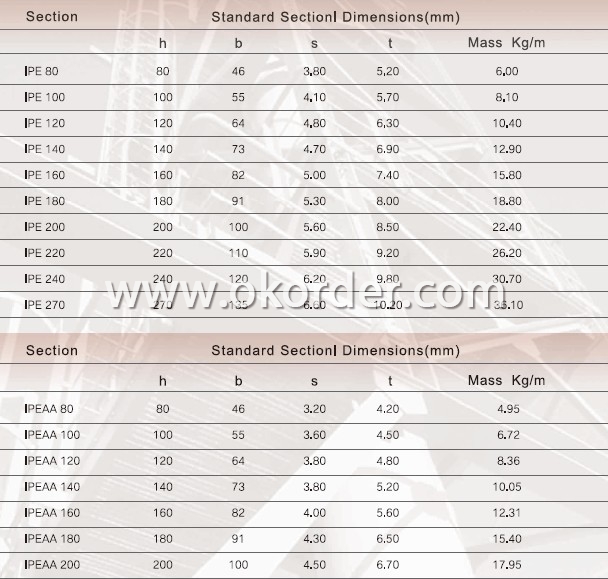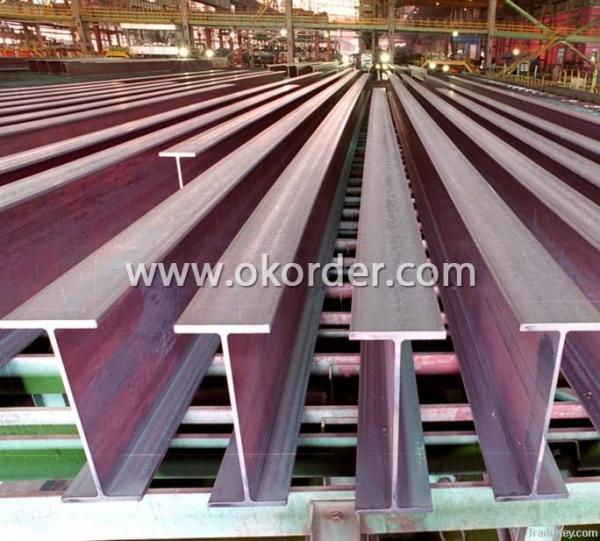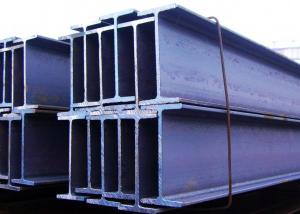I-Beam Steel
- Loading Port:
- Tianjin Port, China
- Payment Terms:
- TT or LC
- Min Order Qty:
- 25MT m.t.
- Supply Capability:
- 10000MT m.t./month
OKorder Service Pledge
OKorder Financial Service
You Might Also Like
Specifications of I-Beam Steel
Product name: I-Beam Steel
Production Standard: GB, BS, ASTM, EN, DIN, JIS
Grade: Q235B, Q345B, ASTM A36, SS400, S235JR, S275JR
Chemical composition
|
Alloy No. |
Grade |
C |
Mn |
S |
P |
Si |
|
Q235 |
B |
0.12%-0.20% |
0.3%-0.7% |
<=0.045% |
<=0.045% |
<=0.3% |
Length: 5.8M, 6M, 8M, 9M, 10M, 12M or as the requirements of the buyer
Sizes: 80MM-270MM

Applications of I-Beam Steel
Widely used in various building structures and engineering structures such as roof beams, bridges, transmission towers, hoisting machinery and transport machinery, ships, industrial furnaces, reaction tower, container frame and warehouse etc.
Package and Delivery
1. Package: All the products will be tired by wire rod in bundles and then put into containers 20', 40' or in bulk cargo.
Or according the requirements of the customers. Each bundle will be hung a CNBM label, which will include the information of our trademark, size, material, lengh, standard, etc. Normally, each bundle contain 50 pieces.
Bundle weight: not more than 3.5MT for bulk vessel; less than 3 MT for container load
But we can also make the bundles as the requriement of you.
2. Delivery: Within 45 days after getting the L/C ORIGINAL or the advance payment by T/T.


Production flow of I-Beam Steel
Material prepare (billet) —heat up—rough rolling—precision rolling—cooling—packing—storage and transportation
- Q:Can steel I-beams be used in theaters or auditoriums?
- Certainly, theaters or auditoriums can make effective use of steel I-beams. In fact, these types of buildings commonly employ steel I-beams in their construction due to their exceptional strength, durability, and versatility. The outstanding structural support provided by steel I-beams allows them to handle heavy loads, making them ideal for supporting significant weights in large open spaces. Furthermore, steel I-beams can be easily fabricated to meet specific design requirements and serve as the foundation for a variety of architectural elements, including balconies, mezzanines, and catwalks. By incorporating steel I-beams into theaters and auditoriums, the safety and stability of the structure are ensured, enabling a seamless integration of lighting, sound equipment, and other essential technical components necessary for performances.
- Q:Can steel I-beams be used for helipad construction?
- Indeed, helipad construction can utilize steel I-beams. When it comes to constructing helipads, steel I-beams are widely chosen and well-liked due to their robustness, endurance, and capacity to bear substantial loads. The structural configuration of I-beams enables them to evenly distribute weight along their length, making them ideal for supporting helicopters during takeoff, landing, and parking. Furthermore, steel I-beams can withstand a variety of weather conditions, such as strong winds and heavy rain, ensuring the stability and durability of the helipad. In conclusion, steel I-beams offer a dependable and effective solution for constructing helipads.
- Q:What are the common inspection and testing methods for steel I-beams?
- Steel I-beams undergo various inspection and testing methods to guarantee their quality and structural soundness. These methods encompass visual examination, ultrasonic testing, magnetic particle testing, and load testing. Visual inspection, the most fundamental and widely utilized method, involves visually scrutinizing the I-beam's surface for any visible flaws like cracks, rust, or deformities. This process allows inspectors to identify apparent issues that may compromise the beams' strength and stability. Ultrasonic testing, another commonly employed method, utilizes high-frequency sound waves to detect internal flaws or defects that may not be discernible to the naked eye. A probe transmits sound waves into the beam, and the reflected waves are analyzed to determine the presence of any abnormalities such as voids, cracks, or delaminations. Magnetic particle testing, a non-destructive method, proves particularly effective in identifying surface and near-surface defects in steel I-beams. This method entails applying a magnetic field to the beam's surface and sprinkling iron particles over it. If any defects are present, the magnetic field will cause the particles to accumulate around them, making them easily visible under appropriate lighting conditions. Load testing, a more comprehensive method, involves subjecting the steel I-beams to controlled loads to assess their structural capacity and performance. Gradually increasing loads are applied until the beam reaches its maximum capacity or fails. Load testing ensures that the beams can withstand specified loads without experiencing excessive deflection or failure. Additionally, other tests such as chemical analysis, hardness testing, and dimensional inspection may also be conducted as part of the inspection process. These tests provide further information about the steel I-beams' composition, strength, and dimensional accuracy. In summary, a combination of these inspection and testing methods is commonly utilized to evaluate the quality and reliability of steel I-beams. This ensures that they meet the required standards and can safely support various structural applications.
- Q:Can steel I-beams be used in cold storage facilities?
- Steel I-beams are indeed suitable for use in cold storage facilities. This is because steel is a commonly chosen material for the structural components in such facilities, owing to its strength, durability, and ability to withstand extreme temperatures. In particular, I-beams are favored for their capacity to bear heavy loads and provide structural support. Thus, in cold storage facilities where maintaining low temperatures is crucial, steel I-beams can be employed to carry the weight of the storage system, equipment, and products, thereby ensuring a secure and dependable structure. Moreover, steel possesses resistance to moisture and corrosion, rendering it appropriate for the cold and potentially damp environment found in storage facilities.
- Q:How are steel I-beams repaired if damaged?
- Steel I-beams are typically repaired if they are damaged by following a specific set of steps. The first step in repairing a damaged steel I-beam is to assess the extent of the damage. This is usually done by a trained professional who examines the beam to determine the severity and location of the damage. Once the damage has been assessed, the next step is to stabilize the beam. This is done by using temporary supports or braces to ensure that the beam is secure and will not collapse during the repair process. This is crucial to ensure the safety of the workers and prevent further damage. After stabilizing the beam, the damaged section needs to be removed. This is often done by cutting out the damaged portion of the beam using cutting tools such as torches or saws. It is important to remove all the damaged material to ensure a proper repair. Once the damaged section has been removed, a new piece of steel is usually fabricated to replace the damaged section. This replacement piece is then carefully welded or bolted into place using specialized techniques and equipment. The welding process is crucial to ensure a strong and durable repair. After the new section is securely attached, the repaired I-beam is often inspected to ensure the quality of the repair. This inspection may involve non-destructive testing methods such as ultrasound or x-ray to detect any potential defects or weaknesses. Finally, if necessary, the repaired I-beam may be painted or treated to protect it from corrosion and extend its lifespan. In summary, repairing a damaged steel I-beam involves assessing the damage, stabilizing the beam, removing the damaged section, fabricating and attaching a new section, inspecting the repair, and potentially painting or treating the beam. This process requires skilled professionals and specialized equipment to ensure a safe and effective repair.
- Q:How are steel I-beams classified?
- Steel I-beams are classified based on their dimensions, specifically their depth (or height), width, and weight per foot. The classification is typically denoted by a series of numbers and letters that represent these dimensions, such as "S" for standard beams or "W" for wide flange beams, followed by the dimensions in inches. For example, a W10x22 beam would have a depth of 10 inches and weigh 22 pounds per foot.
- Q:What are the common installation methods for steel I-beams?
- The common installation methods for steel I-beams include using a crane to lift and place the beams into position, bolting the beams to the supporting structure, and welding the beams in place for added stability.
- Q:Can steel I-beams be used in coastal areas prone to saltwater exposure?
- Yes, steel I-beams can be used in coastal areas prone to saltwater exposure. However, it is important to consider the potential effects of saltwater on the steel beams and take necessary measures to prevent corrosion. Saltwater contains high levels of salt, which can accelerate the corrosion process of steel. To mitigate this risk, several strategies can be employed. Firstly, using corrosion-resistant coatings on the steel beams is crucial. These coatings, such as zinc or epoxy coatings, act as a barrier between the steel and the saltwater, preventing direct contact and reducing the risk of corrosion. Regular inspections and maintenance of the coatings are necessary to ensure their effectiveness over time. Secondly, proper ventilation and drainage systems should be implemented to minimize the accumulation of saltwater on the steel beams. This helps to prevent prolonged exposure to saltwater, reducing the risk of corrosion. Thirdly, selecting the appropriate type of steel for the I-beams is important. Stainless steel or galvanized steel, which have higher resistance to corrosion, are often recommended for structures in coastal areas. Finally, regular maintenance and monitoring of the steel beams are essential to identify and address any signs of corrosion early on. This may involve routine inspections, cleaning, and applying additional protective coatings as needed. By implementing these measures, steel I-beams can be used effectively in coastal areas prone to saltwater exposure, providing structural integrity and durability over time.
- Q:How do steel I-beams perform in areas with high levels of UV radiation?
- Steel I-beams generally perform well in areas with high levels of UV radiation. UV radiation can cause damage and degradation to many materials, including wood, plastic, and some metals. However, steel is known for its durability and resistance to UV radiation. Steel is typically coated with protective layers to prevent corrosion and enhance its resistance to environmental factors, including UV radiation. These coatings, such as galvanization or paint, act as a barrier between the steel and the UV rays, preventing direct exposure and potential damage. Additionally, steel has a high melting point and is not easily affected by the heat generated by UV radiation. Furthermore, the structural design of I-beams adds to their ability to withstand UV radiation. The shape of the I-beam allows for efficient weight distribution and load-bearing capacity, making them less susceptible to warping or distortion due to UV exposure. That being said, prolonged exposure to intense UV radiation over many years can still have some impact on steel I-beams. The protective coatings may eventually wear off, exposing the steel to direct UV radiation, which can lead to some corrosion or surface degradation. However, proper maintenance, such as regular inspections, cleaning, and reapplication of protective coatings, can mitigate these effects and ensure the longevity of steel I-beams in high UV radiation areas. In summary, steel I-beams are generally well-suited for areas with high levels of UV radiation due to their inherent durability and resistance to UV damage. With proper maintenance and protective coatings, steel I-beams can effectively withstand the challenges posed by UV radiation, ensuring their structural integrity and longevity.
- Q:Can Steel I-Beams be used for overhead conveyor systems?
- Definitely! Overhead conveyor systems can indeed make use of steel I-beams. Renowned for their robustness and longevity, steel I-beams are an ideal selection for supporting substantial loads across diverse applications. When employed in overhead conveyor systems, they provide a sturdy and secure framework for attaching the conveyor track, guaranteeing seamless and efficient material handling. Moreover, steel I-beams can effortlessly be tailored to meet specific project prerequisites, including length, width, and load capacity. All in all, due to their strength, adaptability, and ability to manage heavy loads, steel I-beams are a dependable and widely favored choice for overhead conveyor systems.
1. Manufacturer Overview |
|
|---|---|
| Location | Qinhuangdao, China |
| Year Established | 2000 |
| Annual Output Value | Above US$ 300 Million |
| Main Markets | Mid East; Africa; Southeast Asia; Brazil |
| Company Certifications | ISO 9001:2008; |
2. Manufacturer Certificates |
|
|---|---|
| a) Certification Name | |
| Range | |
| Reference | |
| Validity Period | |
3. Manufacturer Capability |
|
|---|---|
| a)Trade Capacity | |
| Nearest Port | Tianjin; |
| Export Percentage | 70% - 80% |
| No.of Employees in Trade Department | 21-50 People |
| Language Spoken: | English; Chinese; |
| b)Factory Information | |
| Factory Size: | Above 400,000 square meters |
| No. of Production Lines | 2 |
| Contract Manufacturing | OEM Service Offered; |
| Product Price Range | Average |
Send your message to us
I-Beam Steel
- Loading Port:
- Tianjin Port, China
- Payment Terms:
- TT or LC
- Min Order Qty:
- 25MT m.t.
- Supply Capability:
- 10000MT m.t./month
OKorder Service Pledge
OKorder Financial Service
Similar products
New products
Hot products
Hot Searches
Related keywords





























